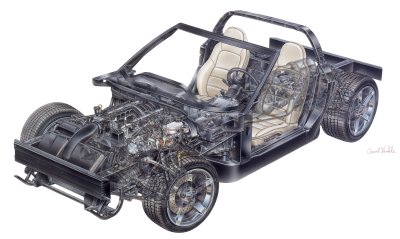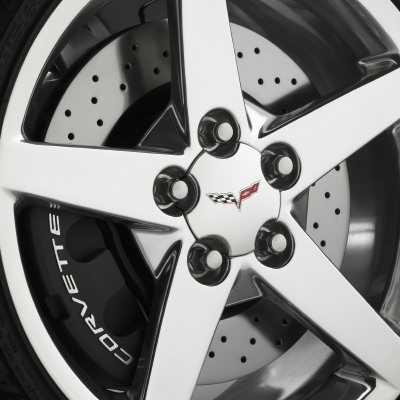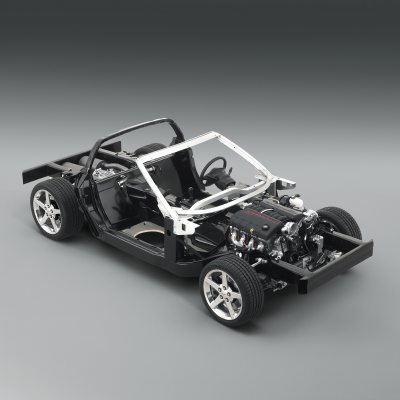|
For
Release: Jan. 1, 2004, 12:01 a.m.
UNDER THE SKIN: BENEATH 2005
Corvette’s SHAPELY CURVES LIES STATE-OF-THE-ART PERFORMANCE
TECHNOLOGY
2005 Corvette is the result of lessons learned from C5-R’s
successes on the track combined with fresh thinking about what a
21st century sports car should be. As the next logical step in the
evolution of GM’s Performance Cars Architecture, it takes its robust
and real-world-validated backbone structure and enhances it with
completely new suspension components.
The key features of the backbone structure – low weight, high
strength via hydroformed steel frame rails, cored composite floors,
enclosed center tunnel, rear-mounted transmission and aluminum
cockpit structure – enable C6’s top speed, world-class handling,
quiet ride and fuel efficiency.
Where the structure has been shortened, it has been strengthened
to enhance its crashworthiness. Optimization in key areas – front
rails, front bumpers, and hood-hinges – resulted in a design that is
more robust yet shorter and lighter than its predecessor.
 Enhanced structure, all-new suspension Enhanced structure, all-new suspension
While
the foundation has been enhanced, every suspension component that
attaches to it has been changed – none of the suspension bits have
been carried over from C5. The short-long arm and transverse leaf
spring independent suspension design remains, but the control arms,
springs, dampers, bushings, stabilizer bars, and steering gear are
completely redesigned. The Extended Mobility Tires (EMT) are also
new, taking advantage of the latest compound technology for run-flat
capabilities, and play a critical role in the tuning of the
suspension for maximum handling and a comfortable ride.
Smoother ride, better handling
Improvements
in ride and handling include greater lateral acceleration, more body
control, a more relaxing ride, less noise transmitted from the road,
and better traction and stability in corners. The specific tuning
changes in the chassis and suspension include suspension and
steering geometry optimized for better handling and ride, advanced
compounds in the tires, new directional control arm bushings, and
greater suspension travel achieved through more clearance in the hub
knuckles and dampers. The progressive rates of the front and rear
composite leaf springs have been tuned to take advantage of the
greater travel of the suspension.
The result is a Corvette that is more poised at higher limits of
handling.
“It’s a much more pleasing ride,” says Mike Neal, ride and
handling development engineer for the 2005 Corvette. “It’s less
touchy, it’s less tuggy, it’s better isolated, it’s quieter for road
noise. It’s all of those things and still a better handling car.
Handling is our first priority in the Corvette.”
Suspension choices
Three suspension choices
allow drivers to choose the setup that best suits their style of
driving. Each of the choices (Corvette Standard, Magnetic Selective
Ride Control, and Z51 Performance Package) provides outstanding
handling, but each also offers drivers the ability to tailor the
car’s handling traits to specific preferences.
The Standard suspension is tuned for a balance of ride comfort
and precise handling. The optional F55 Magnetic Selective Ride
Control suspension adds to the Standard suspension
magneto-rheological dampers that are able to detect road surfaces
and adjust the damping rates to those surfaces almost instantly for
optimal ride and body control.
The optional Z51 Performance Package is a competition-ready
system for the true performance enthusiast. It offers more
aggressive dampers and springs, larger stabilizer bars, Goodyear
Supercar tires with an asymmetrical tread pattern, and larger,
cross-drilled brake rotors for outstanding handling performance that
is still comfortable for daily driving. Beyond the suspension bits,
the Z51 is a total system that takes the “regular” C6 to near-exotic
levels of performance. It features gear ratios borrowed from the
previous Corvette Z06 for maximum acceleration performance, and
includes coolers added for the transmission and power steering
systems for aggressive, track-oriented use. The result is a car that
very nearly equals the Z06 in track performance – representing a
tremendous value.
Next-generation Extended Mobility Tires
The
2005 Corvette takes full advantage of the latest advancements in
tire technology, thanks to its long-running partnership with
Goodyear. That experience resulted in Extended Mobility Tires that
improve both handling capability and ride quality. The tires feature
new compounds and sidewall design which permit the tire to absorb
impacts yet resist heat generated by zero-pressure use. The new
compounds also provide the tremendous grip that Corvette buyers
require for top performance. Despite its lower profile, the design
of the new sidewall is more compliant over bumps and impacts, which
improves ride comfort while reducing noise and isolating the car
from road surface imperfections.
Goodyear is supplying two
different tires, depending on the suspension package. For the
Standard and F55 Magnetic Selective Ride Control suspensions, a
standard directional-tread tire is offered for a balance between
handling and ride. The Z51 Performance Package – the choice for the
serious enthusiast – features an asymmetrical-tread tire that offers
maximum handling performance. The wheel and tire sizes are the same
for the Z51 option, which will deliver handling abilities similar to
the 2004 Z06, despite the slightly narrower width of the new tires.
More robust brakes
With its increased
horsepower and top speed, heartier braking is critical to C6’s
overall balance of performance. The brake systems have been
re-engineered from the previous generation Corvette to provide
improved durability and excellent performance.
 The C6 brake system focuses its improvements chiefly on heat
dissipation and durability requisite of the car’s upgraded overall
performance capability. For the Standard and F55 Magnetic Ride
configurations, the brake rotors remain the same diameter as the C5,
at 12.8 inches in front and 12.0 inches in the rear. However, the
rotors themselves have been thoroughly redesigned. The front rotors
weigh 2 pounds more than the C5, aiding durability. They also
generate less heat against the brake pads, which improves wear and
reduces fade. In all brake applications, the front calipers utilize
dual pistons and the rears use single pistons. The C6 brake system focuses its improvements chiefly on heat
dissipation and durability requisite of the car’s upgraded overall
performance capability. For the Standard and F55 Magnetic Ride
configurations, the brake rotors remain the same diameter as the C5,
at 12.8 inches in front and 12.0 inches in the rear. However, the
rotors themselves have been thoroughly redesigned. The front rotors
weigh 2 pounds more than the C5, aiding durability. They also
generate less heat against the brake pads, which improves wear and
reduces fade. In all brake applications, the front calipers utilize
dual pistons and the rears use single pistons.
The Z51 Performance Package extends the Corvette’s braking
capability with larger diameter rotors (13.4 inches in front and
13.0 inches in rear) that are cross-drilled.
Dynamic chassis control systems
Three
standard dynamic chassis control systems – anti-lock braking,
traction control, and Active Handling – operate in concert to
provide a strong, but unobtrusive safety net for spirited driving.
“Our philosophy for Active Handling is that it should allow
drivers to experience the higher handling limits of C6 without
interfering with their enjoyment of the car,” explains Dave Hill
chief engineer of the Corvette and vehicle line executive for GM
Performance Cars. “Our commitment to continuous improvement has
resulted in the industry’s most sporting stability system
available.”
The anti-lock braking system detects and intervenes to prevent
wheel lockup during braking and features four channels plus a
steering sensor. ABS is tied into the Active Handling stability
system and shares sensors for steering angle, wheel speed, and
acceleration and deceleration in all directions. Traction control
initiates individual wheel braking and/or engine torque reduction
after sensing excessive wheelspin. Active Handling stability control
influences the attitude of the car by applying braking to individual
wheels. The optional Magnetic Selective Ride system integrates with
these systems to enhance handling and body control by optimizing
damping rates based on input from changing road surfaces.
In keeping with Corvette’s performance heritage, and unlike more
intrusive systems of some competitors, the Corvette Team developed a
calibration philosophy based on how Corvette drivers actually drive
their cars. the Corvette Team developed a
calibration philosophy based on how Corvette drivers actually drive
their cars.
“We felt it was better to calibrate the system around our
knowledge of what our customers are going to do, rather than a
system that intervenes heavily and slows them down,” explains Hill.
“Our intent was to encourage Corvette drivers to keep the system on.
We wanted our Active Handling System to work with the drivers in
their spirited driving, rather than against them.”
In all, the C6’s dynamic chassis control systems are smarter,
less intrusive, and more adept at making the total driving
experience precisely what Corvette owners have come to expect from
their car.
|
